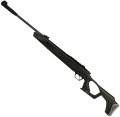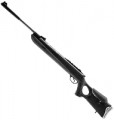Caliber
The caliber of a rifle — that is, the diameter of the bore and, accordingly, the diameter of the ammunition for which it is designed.
The generally accepted standard for freely sold pneumatics in the post-Soviet space is the 4.5 mm caliber; rifles of a larger caliber (standard values — 5.5 mm and 6.35 mm) in most countries in this region are already equated with full-fledged weapons and are sold under the appropriate permits. However,
airsoft models are an exception, primarily
AEG electric drives(see "Type") — their standard caliber is 6 mm, larger values \u200b\u200bare also encountered, while such rifles do not require permits. This is due to the fact that airsoft guns are originally sports equipment, not weapons, they are not designed to cause damage to a particular target, but only to indicate hits on a person, and with a minimal risk of injury. For such an application, just light, but relatively large balls are well suited — an increase in caliber in this case reduces penetration and, accordingly, reduces the risk of injury.
Muzzle velocity
The muzzle velocity provided by the rifle - that is, the speed of the bullet as it exits the barrel.
All other things being equal, a higher bullet speed provides greater range and accuracy, and also simplifies aiming at long distances: the bullet flies along a smoother trajectory and requires fewer adjustments in height, and the influence of side winds decreases with increasing speed. On the other hand, this indicator directly affects the price of the rifle; and in some countries, legal restrictions on the ownership of pneumatic weapons are also related to the muzzle velocity of the bullet.
As for specific values, in the weakest modern rifles the initial speed does not exceed
150 m/s, and in the most powerful it can be
300 - 350 m/s or even
more(remember, the speed of sound is 330 m/s). In general, for recreational shooting at short distances, this parameter is not particularly important, and detailed recommendations for choosing pneumatics for more specific situations can be found in special sources. Let us only note that in AEG electric drives (see “Type”) the initial speed extremely rarely exceeds 150 m/s, but this is done solely for safety reasons: such “weapons” are intended for military-tactical games and initially involve shooting at people, and the high speed would be unsafe for players even with protective equipment.
It is also wor
...th considering that this indicator is not strictly defined. In any type of pneumatic it depends on the weight of the bullet (the lighter the faster); therefore, in the characteristics it is usually customary to indicate a certain average velocity for standard ammunition (usually weighing 0.5 g, in AEG - 0.2 g). In addition, in multi-compression rifles the actual speed of the bullet is determined by the degree of inflation, in gas-cylinder rifles it is determined by the ambient temperature, and in PCP models it is possible to achieve higher speeds than declared by replacing the air with a special gas (for example, helium). Nevertheless, this characteristic makes it possible to evaluate the capabilities of the rifle and compare it with other models, including those that differ in type.Cheek adjustment
The ability to adjust the location of the emphasis under the cheek, located on the butt. Usually, we are talking about at least height adjustment, and in advanced models it may also be possible to move the stop back and forth. Anyway, this feature allows you to adjust the position of the cheek to the physique and personal preferences of a particular shooter, thus providing the most comfortable tab — and this convenience, in turn, has a positive effect on accuracy. At the same time, the ability to
adjust the cheekpiece significantly increases the price of the rifle, and therefore it is found mainly in top-class models.
Swivels
The presence in the design of the rifle
sling swivels — special loops or staples (usually metal) on which the weapon belt is attached. There are usually two such loops — in the front and back of the weapon. In this case, most often the swivels are installed on the underside of the butt and forearm; this design is universal, it allows both right-handed and left-handed people to use the belt with the same comfort. There are also models with a lateral location of the front swivel — usually on the left side of the forearm, under the right-handed hold; however, nowadays in such rifles it is often possible to rearrange the swivel to the other side. So if the pneumatic is bought for a left-hander and it is planned to equip it with a belt, it will not hurt to clarify the features of the sling swivels separately, however, most likely, their design will not create inconvenience.
Barrel length
The working length of the rifle barrel is from the chamber where the bullet is loaded to the muzzle. The shortest barrels found nowadays have a length
of just over 200 mm(and in some AEGs even
less than this value); the longest reach
500 – 600 mm.
There is a stereotype that the muzzle velocity directly depends on the length of the barrel. In firearms, this is true — but not in pneumatics. Firstly, in such rifles, the initial velocity depends on a number of other indicators — pressure, the quality of the barrel treatment, the efficiency of the valves, etc. on the first 20 – 25 cm of the barrel, then the gas pressure drops noticeably. The exception is PCP rifles, in which the longer barrel really makes it easier to achieve high speeds. However, again, so many additional factors affect the final result that models with the same barrel length can differ markedly in initial speed.
The second common stereotype is that a longer barrel improves accuracy and accuracy. This is true in the context that a longer barrel allows for a greater distance between the front and rear sights, making it easier to aim carefully. Technical accuracy does not depend on the length, but on the quality of the barrel processing.
Summing up all of the above, we can say that the length of the barrel for an air rifle is more of a reference than a really significant paramete
...r, and when choosing, it is better to focus on more "close to life" characteristics — first of all, directly claimed muzzle velocity.
